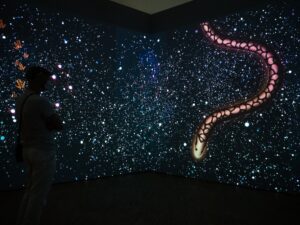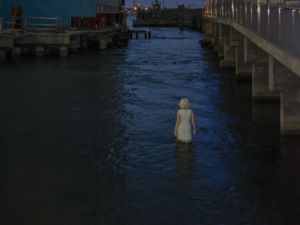British artist Julie Brook draws inspiration from a variety of uninhabited and remote landscapes, from the Jebel Acacus mountains in South West Libya to the semi-desert of North West Namibia. Reflecting on the nature of light, shadow and structure through observational drawings, the artist subsequently creates transient and temporal sculptures made of the fabric of the landscape itself. Shortlisted for the Daiwa Foundation Art Prize 2015, Brook documents these transformations through film and photography. The annual award, organised by the Daiwa Anglo-Japanese Foundation, promotes the work of British artists who have not previously had a solo exhibition in Japan. Fellow finalists for 2015 include Mikhail Karikis and Oliver Beer. We speak to Brook about the impact of being shortlisted for the prize and her ongoing interests in working with the land.
A: You have been shortlisted in the Daiwa Foundation Art Prize 2015. What does this opportunity mean to you?
JB: I have great admiration for the approach Japanese artists have towards their making process where there is a traditional respect for time in developing an inside understanding of work. The depth of skill and experience in relation to the unexpected is integral to an exquisite art form where nature often plays a fundamental role for example in their sculpted gardens. In the development of my sculptural work I look for a distillation of response and form, where often the essence of the work is only revealed to me in the making or once it is finished. One needs time to have a depth of response but at the same time sustaining a degree of spontaneity.
Preparing for the show in London in Japan House has thrown up some good challenges. I have needed to find a new way of exhibiting the films in relation to the drawing as well as being responsive to the gallery space. It has also enabled me to meet a new community of people. It would be incredibly rich to bring the spirit of my work to an audience in Tokyo where their natural environment is challenged. I am excited to meet artists working in Japan in different disciplines, visit stone quarries and kilns and through being with people discover and explore new environments in the wilder regions of Japan that will inspire a new body of work.
A: Drawing and film play fundamental roles in your practice. Why are these mediums important in the development of your artistic expression?
JB: Drawing underlies everything I see and do in terms of being a visual response to my environment whether it is working from observation using pencil and paint or experimenting with gesture and found material. Through drawing I can unselfconsciously build up a relationship with the landscape that enables me to listen to and see what is there so the sculptural work evolves out of that connection rather than me imposing forms. After the intensity of working during an expedition I make large scale drawings in the studio reflecting on and responding to the sculptural ideas that arose. The films enable me to explore the sculptural work on all sorts of levels in terms of shifting perceptions of scale, the nature and physicality of materials and how they sound, movement of light and shadow, time. Through the different rhythms I want to create a sensory and visceral experience for the audience. The films allow me to create relationships between made and unmade forms in the landscape. I think of the films as an extension of my drawing practice.
A: Your work is a direct response to the environment. Do you have any favourite locations that are particularly inspiring?
JB: I am drawn to very wild and uninhabited landscapes and working on the West coast of Jura over a few years in the early 90’s had a profound influence on how I make work. I need to have a sense of inhabiting the landscape and the solitude gives me a concentrated rhythm. Mingulay in the Outer Hebrides, an uninhabited island, is also a very important place to me where I have made work over a 12 year period. I was bowled over by the desert in Libya with such rich variations of colour and material and stark open spaces. In North West Namibia the spirit of the work remains but the physical work changes due to the different environment and light. This is an exciting process and has inspired a huge body of work. I am now looking forward to discovering a new landscape to respond to.
A: Can you talk about the series of works selected for the Daiwa show, and how does this project connect with your wider research?
JB: I have a film cycle of 4 new short films seen in relation to a drawing exploring how the sculptural work defines light and shadow in the spaces and forms I am making. I am interested in the way this distilled way of looking at a wild environment will contrast with the riot of green trees in Regent’s park that the gallery overlooks.
A: What are your upcoming plans and projects?
JB: I am returning to Namibia in the summer to continue my work there. I have been invited to exhibit at the National Gallery in Windhoek in 2016 and would like to tour the films to some of the remote communities who have given me permission to make the work and helped me. I have an exhibition planned for An Lanntair, Lewis in Scotland in Spring 2016 in relation to making work there over an extended period after the show. I have also been invited to participate in a BBC documentary about Land Art coming out in the Autumn 2015. Currently, I am leading a visual arts educational project over the next 2 years, which is an exchange project between primary school children in Skye and Uist. They will be drawing their own and each other’s environment taught through the medium of Gaelic. I am also researching choreographers for a potential collaboration in an outdoor venue where we have to contend with the transient elements such as light and weather.
The Daiwa Foundation Art Prize, Daiwa Foundation Japan House Gallery, 13/14 Cornwall Terrace, London NW1 4QP.
Discover Julie Brook’s work at www.juliebrook.com.
For more information, visit www.dajf.org.uk/grants-awards-prizes/daiwa-foundation-art-prize.
Follow us on Twitter @AestheticaMag for the latest news in contemporary art and culture.
Credits
1. Julie Brook, River Bank 5, Red, 2012. Courtesy of the artist and the Daiwa Anglo-Japanese Foundation.





